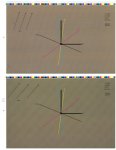OK...
Moiré such as you're experiencing is caused by two two patterns (halftone screens) that are harmonically beating with one another.
The 7.5° offset is used to introduce "noise" in order to eliminate single channel moiré - moiré caused by the screen angle of one separation causing the halftone dots to have pixels on the edge of each halftone dot that themselves have a frequency. I.e. the frequency of the pixels on the edge of each halftone dot forming a repeating pattern that harmonically beat with the frequency of that individual separation - thereby causing a single channel moiré. That is a fairly standard workaround for elliptical screens. You could use a round dot instead to eliminate the need for the 7.5° offset.
Visible interchannel moiré is minimized when the halftone screens are at least 30° apart from one another. There are only three angles where this is possible in 4/C process. So one color will always be less than 30° from its neighbor and hence harmonically beat and result in moiré.
In your 4/C separations
Cyan, Magenta, and Black are 30° away from each other. So, by themselves, those won't show moiré between each other.
Yellow, however, is 15° away from K so, if there is a visible moiré between two colors it will be a Y/K moiré. However, the lpi of the Y separation is typically run at an lpi of 108% of the other process colors. That helps minimize the visibility of the moiré by increasing its periodicity. Y is also much lighter than K (or C and M) so that also helps to reduce the visibility of the moiré.
I don't know the specific screen angles of the anilox roller on your press however, because of the geometries the only screen angles that are available are 90°, 60°, 45°, and 30°
Due to mechanical and printing reasons the recommended angles are typically 45° or 60°.
That makes the most likely potential conflict between the anilox roller screen angle and your separations the M and C channels. (A color separation of 7,5° - 37,5° - 67,5° - 82,5° is based on the assumption that the anilox roller angle is at 45° add or subtract 90° to figure out your angles).
I suggest to ask HD what the lpi and screen angle of your anilox roller is. I think that is where your problem is.
More info on screen angles is here:
The Print Guide: Halftone screen angles
Some other notes: the moiré in digital images that Erik referred to is called a "Demosaicing moiré" - not your problem.
The Y channel is typically 108% of the lpi of the C, M, and K lpi (to minimize Y/X moiré).
If the lpi of the halftone screen is not an even divisor of the dpi of the recording device then a close compromise lpi will be used instead of the requested lpi. I.e. a 200 lpi request could result in a 207 or 196 lpi or something else. The RIP knows best.
The screen angles you are using place the K at a very visible angle - not ideal. It places the M at the least visible angle (45°). That was typically used when UCR separations were the norm as it placed the strong M color at the least visible angle (45°). With the GCR separations used today where K is the dominant color it is probably best to reserve the 45° (or 52.5° with your offset) for the K channel.
The grey levels setting is irrelevant. Basically once the classic output device lpi to dpi ratio is hit ((dpi/lpi) squared + 1 = number of grey levels) halftone dot dithering is used to create grey levels. That is explained here:
The Print Guide: Halftones and grey levels explained
Hope this helps.
Gordo













